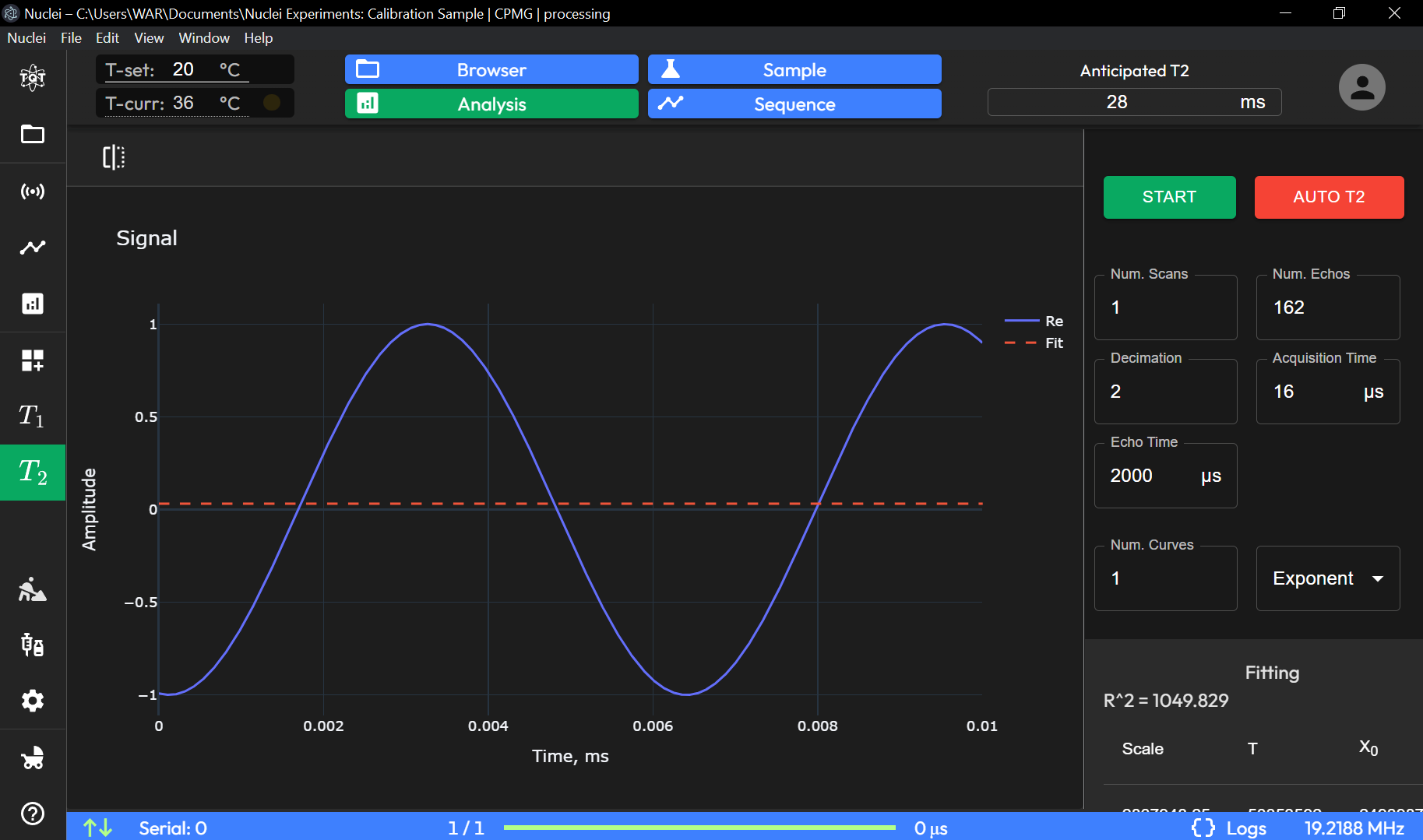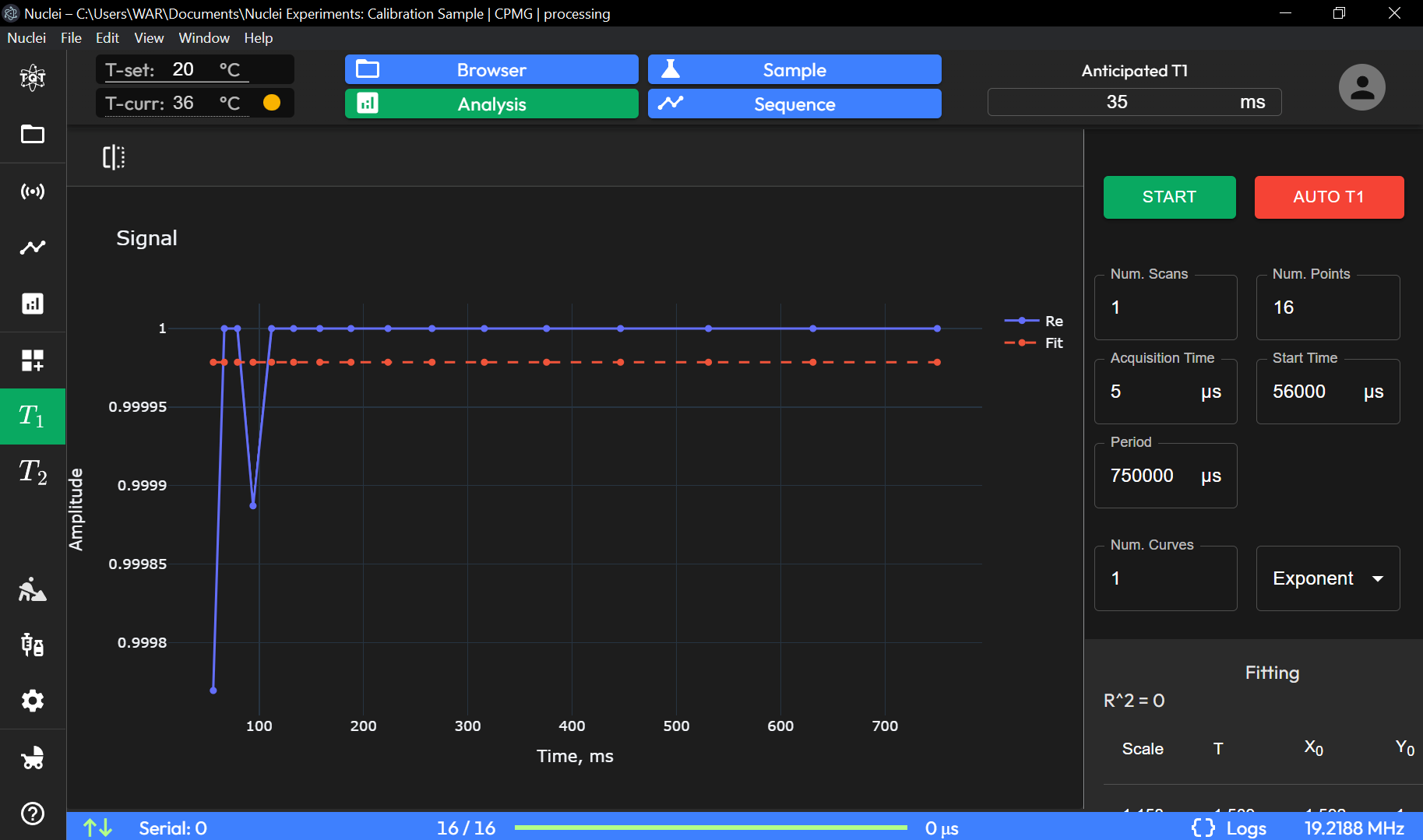T1/T2 Relaxation Time Measurement
The T1 and T2 pages provide preset configurations for measuring the longitudinal (T1) and transverse (T2) relaxation times, respectively. These sections allow for quick setup and execution of relaxation time experiments.
T1 Spin-Lattice Relaxation Page
The T1 Spin-Lattice Relaxation Page provides a streamlined interface for performing routine T1 relaxation time measurements using the inversion recovery method. This page is designed for quick and efficient measurement of T1 times across multiple samples with standardized settings, making it ideal for routine experiments.
Parameters for T1 Measurements:
n_scans: The number of scans per measurement point. More scans improve signal-to-noise ratio but increase experiment time.
n_points: The total number of experimental points on the relaxation curve. More points provide better accuracy for fitting the T1 relaxation curve.
acq (Acquisition Time): The duration of each individual measurement, which determines how long data is collected after the inversion pulse.
start_time: The minimum threshold for the inversion recovery delay (initial point on the T1 relaxation curve). This is the shortest time point where the recovery of magnetization is measured.
period: The maximum delay time, which defines the last point on the T1 relaxation curve. This is used to cover the full range of T1 relaxation times, from the shortest to the longest in the sample.
By running the inversion recovery experiment, the system collects the magnetization recovery data at different time delays, which are then used to calculate the T1 relaxation time.
T2 Spin-Spin Relaxation Page

The T2 Spin-Spin Relaxation Page is optimized for fast measurement of T2 relaxation times using the Carr-Purcell-Meiboom-Gill (CPMG) sequence. This page allows for efficient measurement of T2 across multiple samples, making it suitable for routine laboratory workflows.
Parameters for T2 Measurements:
n_scans: The number of scans per measurement point to improve the signal-to-noise ratio for each echo in the CPMG sequence.
n_echos: The number of echoes collected in the CPMG train. More echoes provide more data points on the T2 decay curve, improving the accuracy of the T2 calculation.
dec (Decimation): Decimation refers to skipping a specified number of p180 pulses in the CPMG train to capture the later parts of the T2 decay without recording every single echo. This is useful for samples with long relaxation times, allowing the experiment to cover more of the relaxation curve in less time.
acq (Acquisition Time): The acquisition time for each individual echo measurement.
echo_time: The basic time delay (τ) between the p90 pulse and the first p180 pulse in the CPMG train. It defines the spacing between echoes in the sequence and, along with decimation, determines the range of the T2 decay curve covered.
The CPMG experiment collects data on how the signal decays after a series of spin-echoes, which is then used to fit the T2 relaxation curve.
These two pages, T1 Spin-Lattice Relaxation and T2 Spin-Spin Relaxation, provide quick access to commonly used NMR relaxation experiments, ensuring that routine measurements can be performed efficiently and accurately.
Page Definitions
Measurement Controls
Anticipated T1 / T2: Input the anticipated T1 or T2 relaxation time (in milliseconds) as an estimate for the measurement.
START: Begins the relaxation time measurement using the defined parameters.
AUTO T1 / AUTO T2: Initiates an automatic measurement mode, using preset parameters for convenience.
Experiment Parameters
Num. Scans: Specifies the number of scans to average during the experiment.
Num. Points / Echos: Defines the number of data points (for T1) or echos (for T2) to collect, corresponding to the number of signal acquisitions.
Acquisition Time: Sets the duration for each data acquisition segment (in microseconds).
Decimation: Adjusts the data resolution by a factor, relevant to the T2 measurement.
Echo Time / Period: Configures the time interval between echos for T2 or the repetition period for T1.
Start Time: (T1 only) Specifies the delay before data acquisition starts for the T1 relaxation measurement.
Curve Fitting Options
Num. Curves: Selects the number of curves to fit to the data, allowing for complex multi-exponential fittings.
Fitting Model: Choose from various models (e.g., Exponent, Gaussian) to apply for data fitting, assisting in extracting accurate relaxation parameters.
Fitting Output
R² Value: Displays the coefficient of determination, providing a measure of fit quality for the selected model.
Fit Parameters: Adjustable parameters such as
Scale,T,X₀, andY₀, which are fitted to the collected data to model the relaxation behavior.
These preset pages streamline the process of measuring T1 and T2 relaxation times, with customizable options for data acquisition and analysis. Users can quickly set up experiments and view results, making this tool useful for both routine measurements and detailed analyses.
